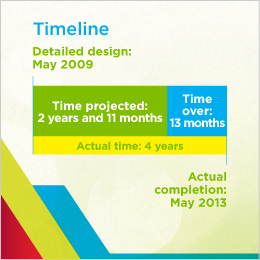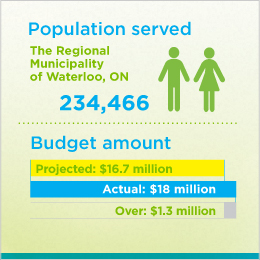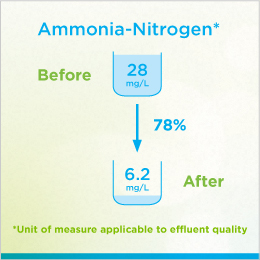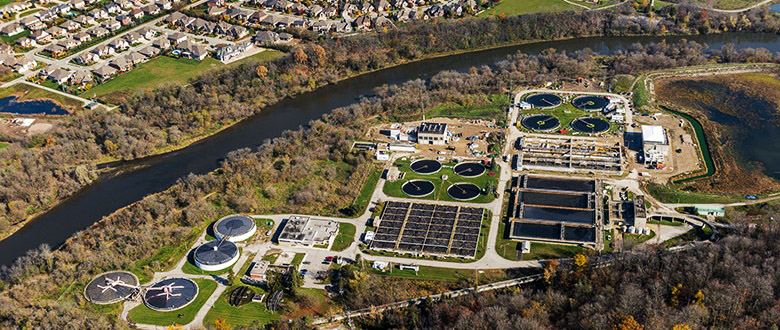This is part of a series of case studies on wastewater projects funded by the FCM's Green Municipal Fund. Each case study provides technical information, project details and tips on best practices.
Project overview
As part of a series of upgrades to the Kitchener Wastewater Treatment Plant (WWTP), the Regional Municipality of Waterloo, ON, implemented an energy-efficient aeration process to treat centrate generated at its new dewatering facility. Prior to the construction of the dewatering facility, biosolids created during water treatment were stored in lagoons and treated with energy-intensive mechanical aeration systems. The new dewatering facility converts biosolids into cake form, generating a side stream of concentrated liquid called centrate, which contains high concentrations of ammonia, phosphorus and organic matter. To treat the centrate and lower the concentrations of ammonia in the final effluent, the region upgraded the plant's aeration technology. The project team retrofitted the existing mechanical aeration tanks with a diffused aeration system, featuring energy-efficient blowers located in a newly constructed building adjacent to the WWTP. The diffused aeration system transmits air to pollutants more efficiently, to better process ammonia and organic nitrogen into nitrate. Construction was done in stages to reduce the impact on plant operations.



Reasons for the project
- The region wanted to implement its Wastewater Treatment Master Plan recommendations on reducing phosphorus and ammonia loadings.
Innovative aspects of the project
- This method of ammonia-nitrogen removal could be replicated widely in municipalities across the country that are dealing with issues related to dewatering, including the challenge of meeting the high environmental standards for biosolids. Generating centrate and removing contaminants from the centrate can help municipalities avoid the higher costs associated with decontaminating biosolids.
Best practices and key lessons
The municipality's experience with this project demonstrates some best practices and key lessons that can inform similar projects.
Engage early and broadly
- Proper coordination among all parties involved (owner, plant operator, contractor and the various consultant engineers working on different projects) and efficient project management are critical for project success.
Include contingencies in the project budget and schedule
- It is important to account for potential weather delays in the construction schedule. The region took a proactive approach, which allowed it to deliver the project on time despite experiencing 30 inclement-weather days. This approach included sequencing activities so that operations at the plant were not disturbed. The region set clear requirements with contractors that their work should be completed prior to payment.
Use effective communications and project management
- Prior to undertaking the project, the region held a public information event to inform the public and receive feedback. Although the event was poorly attended, participants expressed their support and voiced their concerns about odour.
- All members of the project team (the region, the Ontario Clean Water Agency, the consultant and the contractor) were involved in a pre-construction meeting. This meeting was to ensure good communication and to get the schedule endorsed as a priority by all parties. The team reviewed and discussed the schedule at least once a month at progress meetings.
Prepare detailed testing and work plans
- Conduct constructability reviews to maintain continuous plant operations.
- Develop detailed work plans and contingency plans for aspects of the project that involve taking major process units in and out of service.
- Provide as many temporary facilities and controls as needed for the continuous operation of the plant during construction.
- Consider current and future standby power requirements when implementing different phases of a larger project.
Carefully vet proposed new technologies
- Consider whether a proposed new technology has been proven in comparable applications.
- Ensure that the manufacturer provides an extended equipment warranty.
Consider future needs in building design and construction
- By taking future plant requirements into consideration, a municipality can avoid limiting the choices available for meeting those needs.

View of Kitchener Water Treatment Facility site in the Regional Municipality of Waterloo, ON. (Credit: Regional Municipality of Waterloo)
Project benefits
This project yielded a number of environmental, social and economic benefits.
Environmental benefits
- Reduced energy consumption: The project team added variable frequency drives, which ramp up and slow down motors depending on requirements, reducing energy demands.
- Lower energy use: The team replaced mechanical aerators, which are energy-intensive, with diffused aeration systems. In addition, the new blowers installed are energy-efficient. A new heat recovery system in the blower building re-uses waste heat produced by air blowers. Natural lighting and motion sensor lights were also incorporated.
- Improved effluent quality: The project team retrofitted the aeration tank with return activated sludge reaeration, an anoxic zone, and plug-flow configuration, and added new blowers and an air diffusion system. With these upgrades, effluent discharge is no longer ammonia-rich (dropping from 28 mg/L to 6.2 mg/L). Biochemical oxygen demand (BOD) levels have also dropped, by approximately 50 per cent.
- Waste diversion: During project construction, approximately 50 per cent of construction waste was diverted from landfill.
- Biodiversity and ecosystem protection: Improved effluent quality helps to protect the aquatic life in the Grand River.
- Reduced odour: The new dewatering facility and centrate management process minimize odour, which was a problem with the previous biosolids management system involving lagoon storage.
Social benefits
- Protection of public health: Enhanced water quality in the Grand River protects the health of local residents.
Economic benefits
- Reduced operating costs: Operating costs are expected to drop in the long term because of the energy-efficiency features incorporated into the plant. With the reduced volume of biosolids produced through dewatering, transportation costs are reduced as well.
- Support of local economy: Various regional municipalities rely on the Grand River watershed for agricultural activities. Effluent quality improvements ensure that this watershed remains viable for all communities that depend on it.
- Minimized project costs: The city did full-cost accounting and sought fully competitive pricing.

Technical highlights
This project was a new facility. Technical highlights are current as of 2015.
Municipal population: 507,096
Urban/rural: urban
Treatment: Activated sludge
Disinfection
- Before: Chlorine disinfection system
- After: UV disinfection system
Biosolids management
- Before: Lagoon storage with digested sludge used for land application
- After: Centrifuge dewatering to cake, with centrate returned to treatment system, and with dewatered solids used for land application and mine reclamation
Annual average daily flow (AADF)
- Before: 73.0 MLD (million litres per day)
- After: 73.7 MLD
Design capacity: 123 MLD
Per cent of total capacity used for AADF
- Before: 59 per cent
- After: 60 per cent
Total suspended solids (TSS)
- Before: 8.9 mg/L
- After: 8.8 mg/L
Biochemical oxygen demand (BOD)
- Before: 8.4 mg/L
- After: 5.7 mg/L
Project contact information
José R. Bicudo, PhD, P.Eng.
Senior Project Engineer, Wastewater Operations
The Regional Municipality of Waterloo, ON
T. 519-575-4757, ext. 4720
Want to explore all GMF-funded projects? Check out the Projects Database for a complete overview of funded projects and get inspired by municipalities of all sizes, across Canada.

